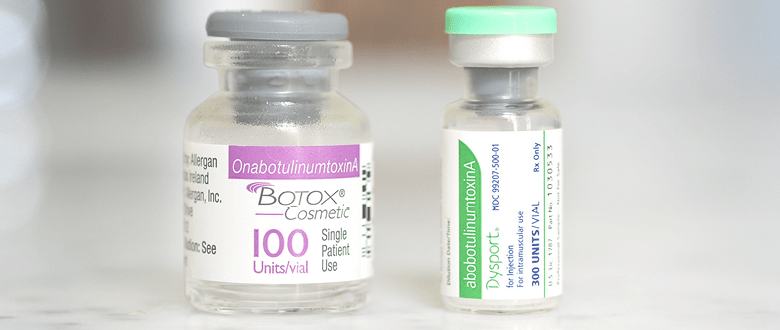The two most commonly asked questions in regards to wrinkle reducers: What is the difference between Botox, Dysport, and Xeomin? And which one is right for me?
It is understandable how one would want to know about Botox, Dysport and Xeomin when trying to determine which treatment is best for them. All three are effective treatments that originate from the same source bacterium, clostridium botulinum. They are synthesized as botulinum toxin type A, the paralyzing agent or neurotoxin that is administered. Each has been consistently proven in clinical trials and then worldwide application. The result is almost always the same: each injectable temporarily paralyzes the targeted muscle areas on the face to relax and ease out the appearance of wrinkles. Due to their proven abilities, each is often paired with dermal fillers, like Juvederm or Radiesse, for dramatic facial rejuvenation.
Botox, Dysport, and Xeomin are all FDA approved and aesthetically designed to smooth and diminish wrinkles. The most common areas treated are crow’s feet, forehead, frown lines around the eye area and brow lifts. However, other areas becoming more popular with patients are the smoker’s lines around the lips, cleavage wrinkling, and even underarm sweating.
When Allergan’s Botox was FDA approved for anti-aging benefits over ten years ago, it was the only brand of its kind on the market in the United States. Botox is a leading cosmetic treatment that drastically reduces the appearance of crow’s feet, lines on the forehead and frown lines. With US FDA approval and the launch of this revolutionary anti-aging product, millions continue to turn to Botox as part of their aesthetic regimen for looking younger.
However, two other companies have entered the market and are having tremendous success: Dysport and Xeomin. Medicis’ Dysport allowed us to give patients a choice in neurotoxins when it came on the market six years ago. Noted benefits of Dysport include that it spreads more than Botox and patients who have stopped responding to Botox commonly use it. It is also injected at a different strength and affects a slightly larger area than Botox and Xeomin.
Yet with both products (Botox & Dysport) containing an accessory protein to carry the botulinum toxin (egg or lactose), the body has the ability to build up antibodies over time, causing the results to diminish after continuous usage. Merz’ Xeomin contains no accessory protein, making it a “pure” version of the botulinum toxin and reducing the risk of an allergic reaction or natural resistance. This solitary agent migrates further and faster to effectively work upon all facial areas upon injection. There is less risk of an allergic reaction or rejection due to the absence of protein additives.
In comparison, Botox and Dysport are considered ‘heavier’ because they contain added proteins. These proteins are for protection and are clustered around the botulinum to enable them to last a little longer. However, the clinical argument is that these protective proteins may also shield the active part of the neurotoxin thereby minimizing product effectiveness. Xeomin is the most similar to Botox when measuring units to units, whereas Dysport requires more units at a lower cost per unit. Both Botox and Xeomin require up to two weeks for full treatment and in most cases Dysport has a much quicker onset for those patients wanting faster results.
All three neurotoxins on the market can last from three to six months, per treatment, varying from patient to patient. It has been reported that Dysport typically takes two to three days until the effects of the treatment are seen. Botox takes seven to ten days, while Xeomin takes five to six days. Dysport may be the best option in areas where several injections are needed because of its easy spreading to cover a greater area on the face. In the areas where the spread needs to be minimized, Botox may be the best option to concentrate on deeper wrinkling.
Over time with different Botox, Dysport and Xeomin injections, patients begin to favor which treatment works best for them. When initially deciding on which neurotoxin to use, consult with a highly experienced aesthetic injector. Botox, Dysport and Xeomin differ in administration technique and injection skills are necessary to determine the proper dosage in order to achieve the best result. Although Affiliated Dermatology does not think one neurotoxin is superior to the other, we offer options for all of our patients with different needs.






